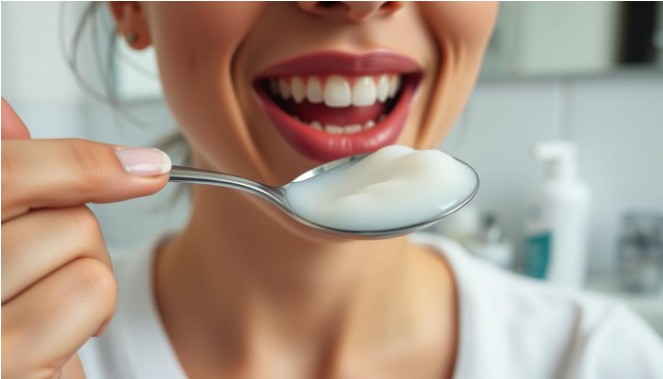Can Oil Pulling Damage Your Teeth? Risks, Benefits, and Expert Opinions

Oil pulling has gained significant popularity as a natural oral health remedy, with many social media influencers and wellness advocates promoting its benefits. But can oil pulling damage teeth? This ancient Ayurvedic practice involves swishing oil around your mouth for several minutes to supposedly remove toxins and improve oral health. While some swear by its effectiveness, dental professionals have raised concerns about potential risks when used incorrectly or as a replacement for conventional dental care.
In this comprehensive guide, we’ll explore what oil pulling is, its claimed benefits, potential risks to your dental health, and what scientific research and dental experts have to say about this controversial practice. Whether you’re curious about trying oil pulling or already incorporate it into your routine, understanding both sides of the debate is essential for making informed decisions about your oral health.
What Is Oil Pulling and Its Traditional Uses?
Oil pulling is an ancient oral hygiene practice that originated in India over 3,000 years ago as part of Ayurvedic medicine. The traditional technique involves swishing a tablespoon of oil around your mouth for 15-20 minutes before spitting it out. Historically, sesame oil was the preferred choice, though today many practitioners use coconut oil due to its pleasant taste and antimicrobial properties.
The practice is based on the Ayurvedic concept that oil can “pull” toxins and bacteria from the mouth and body. According to traditional beliefs, oil pulling should be performed in the morning on an empty stomach for maximum effectiveness. The mechanical action of swishing is thought to remove the soft plaque material that builds up on teeth while the oil’s properties may help reduce harmful bacteria.

In Ayurvedic medicine, oil pulling is believed to address not just oral health concerns but also systemic health issues. Traditional practitioners claim it can help with everything from bad breath and gum disease to detoxifying the body and improving overall wellness. The practice has experienced a resurgence in popularity in Western countries over the past decade, particularly among those seeking natural alternatives to conventional oral care products.
Claimed Benefits of Oil Pulling for Dental Health
Proponents of oil pulling cite numerous benefits for oral health, though it’s important to note that scientific evidence varies in strength for these claims. Here are the most commonly reported benefits:

Reduction in Harmful Bacteria
One of the most well-supported benefits of oil pulling is its ability to reduce harmful bacteria in the mouth. A 2016 study published in the Journal of Clinical and Diagnostic Research found that coconut oil pulling significantly reduced the number of Streptococcus mutans (a primary bacteria responsible for tooth decay) in saliva after just two weeks of daily practice. Some research suggests coconut oil may be as effective as chlorhexidine mouthwash in reducing certain oral bacteria.
Decreased Plaque and Gingivitis
Regular oil pulling may help reduce plaque buildup and gum inflammation. A 2020 study in the European Journal of Dentistry determined that virgin coconut oil was effective at reducing plaque accumulation when used in oil pulling. By reducing bacteria that cause inflammation, oil pulling may help prevent or reduce gingivitis, though more extensive research is still needed to confirm these effects.
Fresher Breath
Bad breath (halitosis) often results from bacteria in the mouth producing unpleasant-smelling compounds. By reducing these bacteria, oil pulling may help improve breath freshness. While specific studies on coconut oil pulling for halitosis are limited, the reduction in plaque and bacteria suggests it could be beneficial for this purpose.

Potential Teeth Whitening
Many oil pulling advocates claim it can whiten teeth over time. While this is one of the most popular reasons people try oil pulling, scientific evidence supporting this specific benefit is currently lacking. Any whitening effect may be related to the overall reduction in plaque rather than any inherent whitening properties of the oils themselves.
“While some benefits of oil pulling are supported by research, others remain anecdotal. The practice may complement traditional oral hygiene but shouldn’t replace proven methods like brushing and flossing.”
Potential Risks: Can Oil Pulling Damage Teeth?
Despite its popularity, oil pulling isn’t without potential risks. Understanding these concerns is crucial before incorporating this practice into your oral care routine.

Delayed Professional Treatment
One of the most significant risks associated with oil pulling is that some people may use it as a substitute for proven dental care methods. Dr. Mark Wolff, Dean of the University of Pennsylvania School of Dental Medicine, warns that while oil pulling itself may not cause direct harm, it becomes problematic when it replaces standard dental care. Relying solely on oil pulling could delay necessary treatment for serious dental conditions like cavities or gum disease.
Potential Lipid Pneumonia Risk
A rare but serious risk associated with oil pulling is lipid pneumonia – a condition caused by oil entering the lungs. A 2015 case study published in the Journal of Oral Health and Community Dentistry documented two patients who developed lipid pneumonia after practicing oil pulling. This typically occurs when oil is accidentally inhaled during the swishing process. While such cases are uncommon, they highlight the importance of proper technique.
Jaw Discomfort and TMJ Issues
The prolonged swishing motion required for traditional oil pulling (15-20 minutes) can strain the jaw muscles and potentially exacerbate existing temporomandibular joint (TMJ) disorders. People with a history of jaw pain, teeth grinding, or TMJ dysfunction should be particularly cautious or consider shorter durations if attempting oil pulling.

Digestive Distress
Accidentally swallowing the oil during pulling can cause digestive issues like nausea, upset stomach, or diarrhea. This is particularly concerning because the oil contains bacteria and toxins that have been pulled from the mouth – precisely what the practice aims to remove from the body. Always spit the oil into a trash can rather than swallowing it or disposing of it in the sink (where it may clog pipes).
Potential Interactions with Dental Work
Some dental professionals express concern that regular oil pulling might affect certain types of dental work. For instance, there are anecdotal reports that prolonged exposure to oils might weaken the cement used in some crowns or bridges, though scientific studies confirming this are lacking. If you have extensive dental work, consult with your dentist before beginning an oil pulling routine.
Important: Oil pulling should never replace regular brushing, flossing, and professional dental check-ups. The American Dental Association does not recommend oil pulling as a dental hygiene practice due to insufficient scientific evidence supporting its effectiveness and safety.
What Science Says About Oil Pulling and Dental Health
Scientific research on oil pulling shows mixed results, with some studies supporting certain benefits while others remain inconclusive. Here’s what current research tells us:

Study on Bacterial Reduction
A 2016 study published in the Journal of Contemporary Dental Practice compared the effectiveness of coconut oil pulling with chlorhexidine mouthwash in reducing Streptococcus mutans bacteria. The study involved 60 participants aged 16-18 years who performed oil pulling for 10 minutes daily. Results showed a significant reduction in S. mutans after just two weeks, comparable to the effects of chlorhexidine mouthwash, which is considered the gold standard for antimicrobial rinses.
Research on Plaque and Gingivitis
A 2017 randomized controlled trial published in the Journal of Indian Society of Periodontology evaluated the antiplaque efficacy of coconut oil pulling. The study involved 40 dental students divided into oil pulling and placebo groups. After 30 days, researchers found that oil pulling effectively reduced plaque formation, though the effect was modest compared to conventional methods. The study concluded that oil pulling could be a complementary method to enhance oral hygiene.

Limitations in Current Research
Despite some promising findings, research on oil pulling has significant limitations. Most studies have small sample sizes, short durations, and sometimes methodological issues. Additionally, there’s a notable lack of research specifically addressing whether oil pulling can damage teeth or dental work over the long term. More comprehensive, long-term studies are needed to fully understand both the benefits and potential risks of this practice.
“Current scientific evidence suggests oil pulling may offer some benefits for reducing oral bacteria and plaque, but claims about whitening teeth or treating serious dental conditions remain unsupported by research.”
Dentists’ Perspectives on Oil Pulling Safety
Dental professionals have varying opinions on oil pulling, though most agree it should complement rather than replace conventional dental care. Here’s what experts have to say:

American Dental Association Position
The American Dental Association (ADA) does not recommend oil pulling as a dental hygiene practice. According to their official statement, “scientific studies have not provided the necessary clinical evidence to demonstrate that oil pulling reduces the incidence of dental caries, whitens teeth, or improves oral health and well-being.” The ADA continues to recommend brushing twice daily with fluoride toothpaste and flossing as the most effective oral hygiene practices.
Expert Opinion: Dr. Mark Wolff
Dr. Mark Wolff, Dean of the University of Pennsylvania School of Dental Medicine, acknowledges that oil pulling likely won’t cause harm but questions its effectiveness compared to standard dental care. “There’s no real reason it would cause harm,” he told Time magazine, “but has it ever reversed periodontitis or gingivitis? The answer is no.” Dr. Wolff suggests that spending the same 20 minutes brushing and flossing would likely provide equal or better cleaning.
Practical Recommendations from Dental Professionals
Many dentists take a middle-ground approach, suggesting that oil pulling can be incorporated as a supplementary practice but should never replace proven dental care methods. Dr. Christine Frank, a dental professional who has reviewed oil pulling research, suggests that those interested in trying oil pulling should:
- Continue regular brushing and flossing
- Maintain routine dental check-ups
- Start with shorter durations (5 minutes instead of 20)
- Be aware of jaw discomfort and stop if pain occurs
- Use oil pulling as a complement to, not replacement for, conventional oral care
Proper Oil Pulling Technique
- Start with just 1 tablespoon of oil (coconut, sesame, or sunflower)
- Begin with shorter durations (5 minutes) and gradually increase if comfortable
- Swish gently to avoid jaw strain
- Spit the oil into a trash can, not the sink (to avoid clogging pipes)
- Rinse thoroughly with warm water afterward
- Brush your teeth as normal after rinsing
When to Avoid Oil Pulling
Oil pulling may not be suitable for everyone. Consider avoiding this practice if you:
- Have TMJ disorders or jaw pain
- Experience difficulty controlling swallowing reflexes
- Have allergies to the oils used
- Are a child (due to risk of swallowing or choking)
- Have extensive dental work (consult your dentist first)
- Are using oil pulling as a replacement for professional dental care

Tip: If you experience any unusual symptoms like persistent jaw pain, tooth sensitivity, or gum irritation after oil pulling, discontinue the practice and consult with your dentist.
Conclusion: Balancing Traditional Practices with Modern Dental Care
The question “can oil pulling damage teeth?” doesn’t have a simple yes or no answer. When practiced correctly as a complement to regular dental care, oil pulling appears to pose minimal risk to dental health for most people. However, potential concerns arise when it’s used incorrectly or as a replacement for proven dental hygiene practices.
Current scientific evidence suggests oil pulling may offer some benefits for reducing oral bacteria and plaque, but claims about whitening teeth or treating serious dental conditions remain largely unsupported by research. The practice’s long history in Ayurvedic medicine and anecdotal success stories suggest there may be value in this traditional approach, but modern dental science still recommends conventional methods as the foundation of oral care.
If you’re curious about oil pulling, consider discussing it with your dentist first, especially if you have existing dental issues or extensive dental work. Remember that even natural remedies can have risks, and the safest approach is to use oil pulling as a supplement to, rather than replacement for, regular brushing, flossing, and professional dental check-ups.

Concerned About Your Dental Health?
If you’re experiencing dental issues or have questions about incorporating practices like oil pulling into your oral care routine, consulting with a dental professional is your best course of action. A dentist can provide personalized advice based on your specific dental health needs.
Frequently Asked Questions About Oil Pulling and Dental Health
How long should I practice oil pulling for optimal results?
Traditional Ayurvedic practice recommends 15-20 minutes of oil pulling, but modern adaptations suggest that even 5-10 minutes may provide benefits. If you’re new to oil pulling, start with shorter durations and gradually increase as comfortable. The key is consistency rather than duration.
Can oil pulling replace regular brushing and flossing?
No, oil pulling should not replace regular brushing and flossing. Dental professionals, including the American Dental Association, emphasize that oil pulling lacks the scientific evidence to support it as a primary oral hygiene method. Continue brushing twice daily with fluoride toothpaste and flossing daily.
Is coconut oil better than other oils for oil pulling?
Coconut oil is popular for oil pulling due to its pleasant taste and antimicrobial properties from lauric acid. However, traditional Ayurvedic practice often used sesame oil. Both oils have shown some benefits in studies, so the choice may come down to personal preference and taste.
Can oil pulling help with existing cavities?
Oil pulling cannot reverse existing cavities or replace professional dental treatment for tooth decay. While it may help reduce bacteria that contribute to cavity formation, once enamel is damaged, professional dental intervention is necessary. Never delay seeing a dentist for a suspected cavity.
Is oil pulling safe for people with dental fillings, crowns, or bridges?
There’s limited research on how oil pulling affects dental work. Some dentists express concern that prolonged exposure to oils might potentially affect certain materials used in restorations. If you have extensive dental work, consult with your dentist before beginning oil pulling.






